Samsung begins producing its battery-saving memory chips for phones
Smartphone makers are finding it difficult to make their phones stand out in an increasingly competitive market. As well as continuously rolling out new software features and improved displays, sometimes an effective solution can be as simple as upgrading internal components to guarantee better performance and longer battery life. That’s what Samsung’s second-generation 10nm (1y-nm) class 16Gb LPDDR4X Mobile DRAM is all about.
According to Samsung, the scaled-down memory chip — which has just gone into production — will help upcoming mobile flagship devices (like the Samsung Galaxy S10) offset issues like battery drain. The 16Gb LPDDR4X DRAM still achieves the 4,266 Mbps data rate present in current flagship smartphones, but manages up to a 10 percent decrease in power consumption.
By combining four 16Gb (16Gb = 2GB) LPDDR4X DRAM chips, Samsung built an 8GB LPDDR4X mobile DRAM package that has been slimmed down by approximately 20 percent compared to its 1st gen predecessor.
Samsung’s strides to amplify its DRAM lineup intensified last year with the unveiling of its tinier, more energy efficient 8Gb DDR4 RAM chips for PC. The company plans to continue expanding its 1y-nm based DRAM lineup by over 70 percent, and is promising 4GB, 6GB and, 8GB LPDDR4X packages for all types of mobile devices.
(34)




